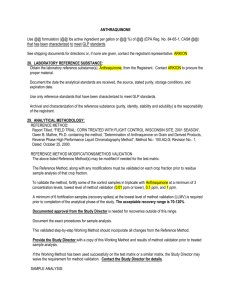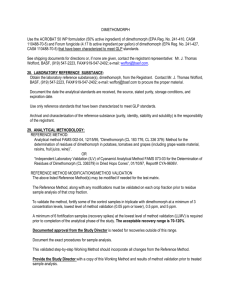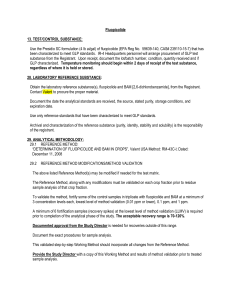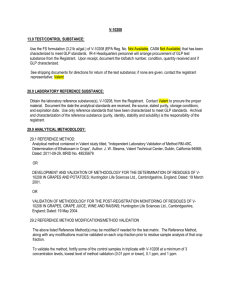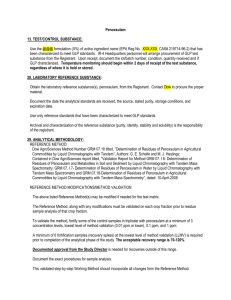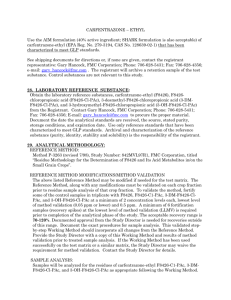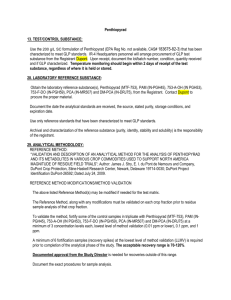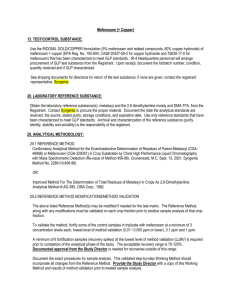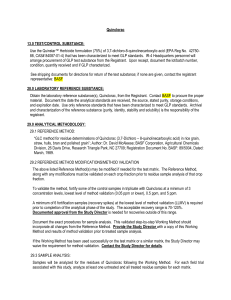BIFENAZATE
advertisement
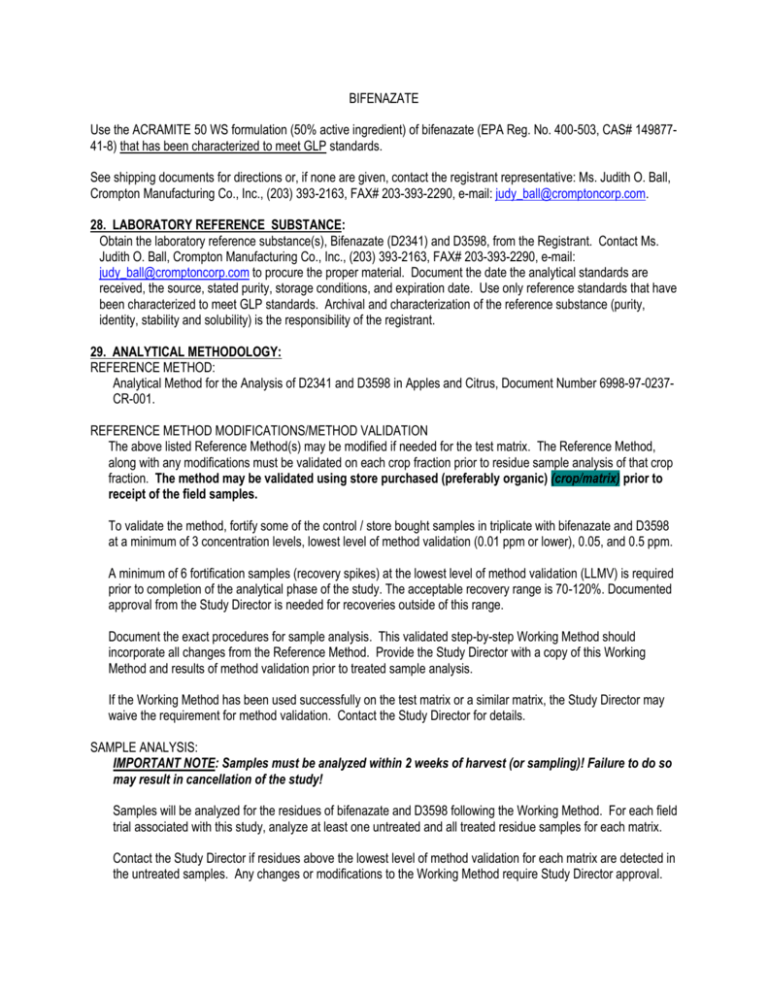
BIFENAZATE Use the ACRAMITE 50 WS formulation (50% active ingredient) of bifenazate (EPA Reg. No. 400-503, CAS# 14987741-8) that has been characterized to meet GLP standards. See shipping documents for directions or, if none are given, contact the registrant representative: Ms. Judith O. Ball, Crompton Manufacturing Co., Inc., (203) 393-2163, FAX# 203-393-2290, e-mail: judy_ball@cromptoncorp.com. 28. LABORATORY REFERENCE SUBSTANCE: Obtain the laboratory reference substance(s), Bifenazate (D2341) and D3598, from the Registrant. Contact Ms. Judith O. Ball, Crompton Manufacturing Co., Inc., (203) 393-2163, FAX# 203-393-2290, e-mail: judy_ball@cromptoncorp.com to procure the proper material. Document the date the analytical standards are received, the source, stated purity, storage conditions, and expiration date. Use only reference standards that have been characterized to meet GLP standards. Archival and characterization of the reference substance (purity, identity, stability and solubility) is the responsibility of the registrant. 29. ANALYTICAL METHODOLOGY: REFERENCE METHOD: Analytical Method for the Analysis of D2341 and D3598 in Apples and Citrus, Document Number 6998-97-0237CR-001. REFERENCE METHOD MODIFICATIONS/METHOD VALIDATION The above listed Reference Method(s) may be modified if needed for the test matrix. The Reference Method, along with any modifications must be validated on each crop fraction prior to residue sample analysis of that crop fraction. The method may be validated using store purchased (preferably organic) (crop/matrix) prior to receipt of the field samples. To validate the method, fortify some of the control / store bought samples in triplicate with bifenazate and D3598 at a minimum of 3 concentration levels, lowest level of method validation (0.01 ppm or lower), 0.05, and 0.5 ppm. A minimum of 6 fortification samples (recovery spikes) at the lowest level of method validation (LLMV) is required prior to completion of the analytical phase of the study. The acceptable recovery range is 70-120%. Documented approval from the Study Director is needed for recoveries outside of this range. Document the exact procedures for sample analysis. This validated step-by-step Working Method should incorporate all changes from the Reference Method. Provide the Study Director with a copy of this Working Method and results of method validation prior to treated sample analysis. If the Working Method has been used successfully on the test matrix or a similar matrix, the Study Director may waive the requirement for method validation. Contact the Study Director for details. SAMPLE ANALYSIS: IMPORTANT NOTE: Samples must be analyzed within 2 weeks of harvest (or sampling)! Failure to do so may result in cancellation of the study! Samples will be analyzed for the residues of bifenazate and D3598 following the Working Method. For each field trial associated with this study, analyze at least one untreated and all treated residue samples for each matrix. Contact the Study Director if residues above the lowest level of method validation for each matrix are detected in the untreated samples. Any changes or modifications to the Working Method require Study Director approval. Whenever possible, notify the Study Director prior to occurrence. Any change or modification to the Working Method should be documented in the raw data and discussed in the final report. A typical analytical set (or run) should consist of calibration standards, untreated sample(s), concurrent recovery sample(s), and treated sample(s). Each analytical set must begin and end with a calibration standard. Additional calibration standards should be injected with sample analysis to ensure goodness of fit to the standard curve. Over the course of residue sample analysis, adequate concurrent recovery samples that bracket the actual residues should be analyzed. At least one concurrent fortification sample should be analyzed per analytical set. The Study Director should be immediately notified if concurrent recoveries deviate from the acceptable recovery range of 70% to 120%. All efforts will be made to resolve existing recovery problems before continuing forward with additional analytical sets. If residues in samples are above the highest Working Method validation concentration, additional recovery samples at levels above actual residues must be run in triplicate as soon as practical. STORAGE STABILITY ANALYSIS: Not required for this study if samples are analyzed within 2 weeks of sampling. If that is not feasible then, as soon as possible after receipt of samples, a minimum of nine subsamples of all available crop fractions of the control shall be fortified with bifenazate and D3598 at 1 ppm each. Three samples of each analyte and crop fraction will be analyzed along with or shortly after method validation. Contact the Study Director if the recoveries of the storage stability samples analyzed with or shortly after method validation differ from the method validation and concurrent recoveries. Three samples of each analyte and crop fraction will be analyzed after the appropriate storage period (generally, greater than the longest interval that an individual sample was stored between collecting the sample in the field/processing facility and analysis, unless otherwise specified by the Study Director). The remaining samples will be retained for long-term storage. If analysis of treated/control samples is completed within 30 days of harvest, analysis of storage fortification samples may not be required. If appropriate, contact Study Director. STATISTICAL METHOD(S): Utilize regression analysis to determine the linearity of the standard curve (r2) or the goodness of fit if the standard curve is non-linear. Criteria for acceptance of the standard curve(s) or other statistical methods shall be determined by Laboratory Research Director and documented in the raw data.
